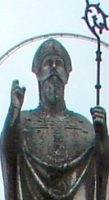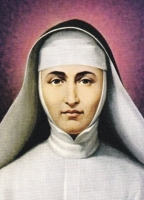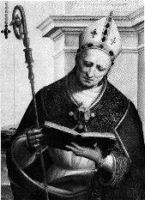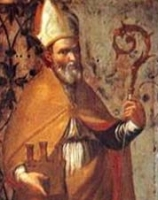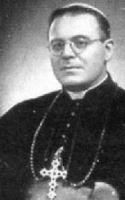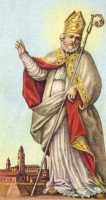St. Joseph Pignatelli
ஜோசஃப் பிக்னடெல்லி
இயேசு சபையை புதுப்பித்தவர்:
(Restorer of the Society of Jesus)
பிறப்பு: டிசம்பர் 27, 1737
ஸரகோஸா, ஸ்பெயின்
(Zaragoza, Spain)
இறப்பு: நவம்பர் 15, 1811 (வயது 73)
ரோம், முதலாவது ஃபிரெஞ்ச் பேரரசு
(Rome, First French Empire)
ஏற்கும் சமயம்:
ரோமன் கத்தோலிக்க திருச்சபை - இயேசு சபை
(Roman Catholic Church - Society of Jesus)
முக்திபேறு பட்டம்: மே 21, 1933
திருத்தந்தை பதினொன்றாம் பயஸ்
(Pope Pius XI)
புனிதர் பட்டம்: மே 12, 1954
திருத்தந்தை பனிரெண்டாம் பயஸ்
(Pope Pius XII)
முக்கிய திருத்தலம்:
"கேஸு" ஆலயம்; பியஸ்ஸா டெல் கெஸ், ரோம், இத்தாலி
(Church of the Gesù; Piazza del Ges, Rome, Italy)
நினைவுத் திருநாள்: நவம்பர் 14
புனிதர் ஜோசஃப் மேரி பிக்னடெல்லி, ரோமன் கத்தோலிக்க திருச்சபையின் ஸ்பேனிஷ் குருவும், இயேசு சபைச் சமூகம் ஒடுக்கப்பட்டதன் பின்னர், “சார்டினியாவில்” (Sardinia) இயேசு சபையினர் நாடுகடத்தலின்போது அச்சபையினரின் அதிகாரபூர்வமற்ற தலைவராக செயல்பட்டவருமாவார். இயேசு சபையை மீட்டு புதுப்பித்ததன் காரணமாக, அவர் இயேசு சபை சமூகத்தின் இரண்டாம் நிறுவனராக கருதப்பட்டார்.
பிக்னடெல்லி, ஸ்பெய்ன் நாட்டின், “ஸரகோஸா” (Zaragoza) மாநிலத்தின் “நியோபோலிடன்” (Neapolitan) வம்சாவளியின் உன்னத பரம்பரையில் பிறந்தவராவார். அவர் தமது ஆரம்பக் கல்வியை தமது சகோதரர் “நிக்கோலசுடன்” (Nicolás) இணைந்து இயேசு சபை பள்ளியில் பயின்றார். அங்கே அவருக்கு காச நோயும் பிளேக் என்னும் நோய்த்தொற்றும் ஏற்பட்டது. இதன் காரணமாக இவர் தமது வாழ்நாள் முழுதும் துன்புற்றார்.
கி.பி. 1753ம் ஆண்டு, மே மாதம், 8ம் தேதி, தமது பதினைந்தாம் வயதில், “டர்ரகொனா” (Tarragona) எனும் இடத்திலுள்ள இயேசு சபையில் பெற்றோரின் எதிர்ப்பையும் மீறி இணைந்த இவர், தமது கத்தோலிக்க இறையியல் கல்வியை பூர்த்தி செய்து குருத்துவ அருட்பொழிவு பெற்றார். பின்னர் “ஸரகோஸா” (College of Zaragoza) கல்லூரியில் கற்பிக்கும் பணியிலமர்த்தப்பட்டார்.
கி.பி. 1766ம் ஆண்டில் ஏற்பட்ட பஞ்சத்துக்கு ஸரகோஸா ஆளுநர் பொறுப்பாக்கப்பட்டார். இதனால் ஆத்திரமுற்ற பொதுமக்கள், ஆளுநரின் மாளிகையை தீயிட்டு கொளுத்த முற்பட்டனர். மக்களை வசப்படுத்தியிருந்த பிக்னடெல்லியின் முயற்சியால் பேரிடர் தவிர்க்கப்பட்டது. ஸ்பெயின் அரசர் “மூன்றாம் சார்லஸ்” (King Charles III of Spain) அனுப்பிய நன்றி நவிலல் கடிதத்தையும் மீறி கலகமூட்டியதாகவும், தூண்டியதாகவும், இயேசு சபையினர் குற்றம் சாட்டப்பட்டனர். மேற்சொன்ன குற்றச்சாட்டினை பிக்னடெல்லி மறுத்ததால் அவரும் இயேசு சபையினரும் கி.பி. 1767ம் ஆண்டு, ஏப்ரல் மாதம், 4ம் தேதி, ஸரகோஸாவை விட்டு வெளியேற ஆணை பிறப்பிக்கப்பட்டது.
பிக்னடெல்லியும், இயேசு சபையின் மற்றுமொரு அங்கத்தினரான - அவரது சகோதரர் நிக்கொலசும் இயேசு சபையை விட்டு விலகுவதானால் ஸரகோஸா நகரிலேயே இருக்க அனுமதிப்பதாக அரசனுடைய கையாளும், இயேசு சபையினரை வெளியேற்றுவதை ஊக்குவிப்பவருமான "அராண்டா" பிரபு (The Count of Aranda) கூறினார். ஆனால், தமது நோயையும் பொருட்படுத்தாத பிக்னடெல்லியும் அவரது சகோதரர் நிக்கொலசும் அதற்கு ஒப்புக்கொள்ள மறுத்தனர்.
நாடு கடத்தல் :
ஸரகோஸா'விலிருந்து நாடு கடத்தப்பட்ட இயேசு சபையினர் இத்தாலியிலுள்ள "ஸிவிட்டவெச்சியா" (Civitavecchia) என்னுமிடத்தில் இறங்க திருத்தந்தை பதின்மூன்றாம் கிளமென்ட் (Pope Clement XIII) அனுமதி வழங்க மறுத்ததால், அவர்கள் கடல்வழியாக "கோர்ஸிகன் குடியரசுக்கு" (Corsican Republic) பயணித்தனர்.
கி.பி. 1770ல் ஃபிரான்ஸ், கோர்ஸிக்கா (Corsica) நாட்டை தனது கட்டுப்பாட்டில் எடுத்துக்கொண்டபோது, இயேசு சபையினர் ஜெனோவா (Genoa) சென்று தங்க அனுமதிக்கப்பட்டனர்.
எனினும், கி.பி. 1773ம் ஆண்டு, ஆகஸ்ட் மாதம், இயேசு சபையினர் முழு சமுதாயத்தையும் திருத்தந்தை “பதினான்காம் கிளமென்ட்” (Pope Clement XIV) அவர்களால் நசுக்கி கலைக்கப்பட்டது. பிக்னடெல்லி சகோதரர்கள் இருவரும் வடக்கு இத்தாலியின் பிராந்தியமான “எமிலியா-ரொமாக்னாவின்” (Emilia-Romagna) தலைநகரான “பொலோக்னாவில்” (Bologna) தஞ்சம் பெற அனுமதிக்கப்பட்டனர். அங்கே ஓய்வு பெற அனுமதிக்கப்பட்ட அவர்கள், தமது கிறிஸ்தவ ஊழியங்களில் ஈடுபடக்கூடாது என்ற கட்டுப்பாடுகள் விதிக்கப்பட்டனர்.
சில வருடங்களின் பின்னர், புதிதாய் தேர்ந்தெடுக்கப்பட்டிருந்த திருத்தந்தை ஆறாம் பயஸ், (Pope Pius VI) வாழும் முன்னாள் இயேசு சபையினரை ரஷிய பேரரசிலுள்ள இயேசு சபையினருடன் சந்தித்து உரையாட அனுமதி வழங்கினார்.
முன்பொருமுறை, கி.பி. 1768ம் ஆண்டு, பிக்னடெல்லியையும் மற்றுமுள்ள இயேசு சபையினரையும் பலாத்காரமாக நாடு கடத்திய "அராண்டா பிரபுவான” (The Count of Aranda) “ஃபெர்டினான்ட்” (Ferdinand), இம்முறை தமது பூமியான, இத்தாலிய பிராந்தியமான “பார்மாவில்” (Parma) அவர்கள் நிரந்தரமாக தங்கிக்கொண்டு, இயேசுசபையை மறுநிர்மாணம் செய்துகொள்ள அனுமதித்தான். கி.பி. 1793ம் ஆண்டு, ரஷியப் பேரரசி “இரண்டாம் கேதரனின்” (Empress Catherine II of Russia) அனுமதியுடன், ரஷியாவின் சில இயேசுசபை தந்தையருடன், வேறு சில இயேசுசபையினருடன் இணைந்து, புதிய சபை நடைமுறை செய்யப்பட்டது.
கி.பி. 1797ம் ஆண்டு, ஜூலை மாதம், 6ம் தேதி, பிக்னடெல்லி தமது மத சத்திய பிரமாணங்களை புதுப்பித்துக் கொண்டார். இயேசு சபையினர் தமது வழக்கமான சமய சடங்குகளை நடத்தத் தொடங்கினர். கி.பி. 1799ம் ஆண்டு, இத்தாலிய பிராந்தியமான “பார்மாவின்” (Parma) நகரான “கொலோர்னோவிலுள்ள” (Colorno) புதிய புகுமுக பயிற்சியாளர் (New Novitiate) மடத்தின் புதிய தலைவராக (Master of Novices), திருத்தந்தையின் அனுமதியுடன் நியமிக்கப்பட்டார். கி.பி. 1802ம் ஆண்டு, “பார்மாவின் பிரபு” (Duke of Parma) மரணமடைந்ததும், அம்மாநிலம் ஃபிரான்சுடன் இணைத்துக்கொள்ளப்பட்டது. கி.பி. 1800ம் ஆண்டு, திருத்தந்தை ஏழாம் பயஸ் (Pope Pius VII), இத்தாலிய பிராந்தியத்தின் இயேசுசபை தலைவராக (Provincial Superior of the Jesuits) இவரை நியமித்தார். இத்தாலியின் தன்னாட்சிப் பகுதியும், “மத்தியதரைக் கடலிலுள்ள” (Mediterranean Sea) பெரும் தீவுமான “சிசிலியில்” (Sicily) பள்ளிகளும் கல்லூரிகளும் திறக்கப்பட்டன. பிக்னடெல்லி, “ரோம்” (Rome), “டிவோலி” (Tivoli), மற்றும் “ஒர்வியேட்டோ” (Orvieto) ஆகிய நகரங்களில் கல்லூரிகளை நிறுவினார். இயேசுசபை தந்தையர் படிப்படியாக மற்ற நகரங்களுக்கும் அழைக்கப்பட்டனர்.
திருத்தந்தை “ஏழாம் பயசின்” (Pope Pius VII) நாடு கடத்தலின்போதும், ஃபிரான்ஸ் நாடு திருத்தந்தையர் மாநிலங்களை (French occupation of the Papal States) கைப்பற்றியபோதும், விழிப்புடைமைக்கு பெரும்பாலும் காரணமாக இருந்த பிக்னடெல்லியின் தலைமையின் கீழே இயேசு சபையினர் எவ்வித பாதிப்பும் இன்றி பாதுகாப்பாக இருந்தனர்.
மரணமும் புனிதர் பட்டமும்:
ரோம் நகரம், ஃபிரான்ஸின் ஆக்கிரமிப்பில் இருந்தபோது, காச நோயின் தீவிரத்தால் ஏற்பட்ட குருதிப் போக்கு பிக்னடெல்லியின் மரணத்துக்கு காரணமாய் அமைந்தது. கி.பி. 1811ம் ஆண்டு, நவம்பர் மாதம், 15ம் நாள், ஜோசஃப் மேரி பிக்னடெல்லி மரித்தார். அன்னாரது பூவுடல், ரோமிலுள்ள இயேசு சபையின் தேவாலய பலிபீடத்தின் கீழே அடக்கம் செய்யப்பட்டுள்ளது.
கி.பி. 1933ம் ஆண்டு, மே மாதம், 21ம் தேதி, திருத்தந்தை பதினோராம் பயஸ் (Pope Pius XI), இவருக்கு முக்திபேறு பட்டமளித்தார்.
கி.பி. 1954ம் ஆண்டு, ஜூன் மாதம், 12ம் தேதி, திருத்தந்தை பனிரெண்டாம் பயஸ் (Pope Pius XII) அவருக்கு புனிதர் பட்டமளித்தார்.
Joseph Pignatelli is remembered for his kindness, humility, gracious manner, as well as for his undaunted courage in keeping his exiled companions united in spirit. He is, in some respects, almost regarded as a second founder of the Order.
Jesuit confessor and one of the restorers of the Society of Jesus after its suppression in 1773. He was born in Saragossa, Spain, and became a Jesuit at the age of fifteen. When the Jesuits were suppressed at the command of the pope and under intense pressure from the European monarchs, he resided in Bologna, Italy, for two decades. In 1799, he opened a new semiofficial novitiate for the Jesuits, laying the foundation for the eventual restoration of the Society of Jesus by Pope Pius VII in 1814. Pope Pius XI described him as a priest of "manly and vigorous holiness," and Pius XII termed him the "restorer of the Jesuits." Joseph was canonized in 1954.
Joseph Mary Pignatelli (Spanish: José María Pignatelli) (27 December 1737 – 15 November 1811) was a Spanish priest who was the unofficial leader of the Jesuits in exile in Sardinia, after the suppression of the Society of Jesus. Supervising its restoration, he is considered second founder of the Society of Jesus.
St. Gregory Palamas
Born 1296
Constantinople,
(modern-day İstanbul, Turkey)
Died 1359 (aged 62-63)
Thessaloniki, Macedonia
(modern-day Greece)
Venerated in Eastern Orthodox Church
Eastern Catholic Churches
Anglican Communion
Canonized 1368, Constantinople by Patriarch Philotheos of Constantinople
Major shrine Thessaloniki
Feast Second Sunday of Great Lent
November 14
Attributes Long, tapering dark beard, vested as a bishop, holding a Gospel Book or scroll, right hand raised in benediction
Influenced Nilus Cabasilas, Gennadius Scholarius, Nicodemus the Hagiorite, Sophrony of Essex, John Meyendorff, Seraphim Rose
The scion of a noble Anatolian family, St. Gregory was born, probably at Constantinople, c. 1296. After his father's death, he became a monk, as did several members of his family. He entered a monastery on Mt. Athos and followed the rule of St. Basil. He lived on Athos in solitude for most of the following twenty years. In the 1330's, he began to defend the practice of hesychasm against the attacks of people like Barlaam of Calabria, who denied, among other things, that the light of Tabor which hesychasts experience is the uncreated light. Athough the 1341 council of Constantinople upheld Gregory's teachings about theosis, he was excommunicated in 1344. Three years later, he was consecrated bishop of Thessaloniki. Because hesychasm had come to have political as well as theological associations, the choice was not popular, and he entered his see with the aid of the Byzantine emperor. The Turks captured Gregory in 1354 and kept him captive for a year. He died in 1359. Gregory believes that although God is ultimately unknowable, man can experience his energies through the sacraments and mystical experience, which are possible because of the Incarnation of Christ. The practice of the Jesus prayer opens one to God's energies.
Gregory Palamas (Greek: Γρηγόριος Παλαμᾶς; c. 1296 – 1359[1]) was a Byzantine Greek theologian and Eastern Orthodox cleric of the late Byzantine period. A monk of Mount Athos (modern Greece) and later archbishop of Thessaloniki, he is famous for his defense of hesychast spirituality, the uncreated character of the light of the Transfiguration, and the distinction between God's essence and energies (i.e., the divine will, divine grace, etc.). His teaching unfolded over the course of three major controversies, (1) with the Italo-Greek Barlaam between 1336 and 1341, (2) with the monk Gregory Akindynos between 1341 and 1347, and (3) with the philosopher Gregoras, from 1348 to 1355. His theological contributions are sometimes referred to as Palamism, and his followers as Palamites.
Gregory has been venerated as a saint in the Eastern Orthodox Church since 1368. Within the Catholic Church, he has also been called a saint; Pope John Paul II repeatedly called Gregory a great theological writer.[2] Since 1971, the Melkite Greek Catholic Church has venerated Gregory as a saint.[3][4] Some of his writings are collected in the Philokalia, and since the Ottoman period, the second Sunday of Great Lent is dedicated to the memory Gregory Palamas in the Orthodox Church and Ukrainian Greek Catholic Church.[5] The Byzantine Synodikon of Orthodoxy also celebrates his memory and theology while condemning his opponents, including some anti-Palamites who flourished after Gregory's death.
Blessed John Licci
Also known as
John Liccio
Profile
Born to a poor farm family, John's mother died in childbirth. His life from then on, all 111 years, was a tale of miracles.
John's father, who fed the baby on crushed pomegranates, had to work the fields, and was forced to leave the infant alone. The baby began crying, and a neighbor woman took him to her home to feed him. She laid the infant on the bed next to her paralyzed husband - and the man was instantly cured. The woman told John's father of the miracle, but he was more concerned that she was meddling, and had taken his son without his permission. He took the child home to feed him more pomegranate pulp. As soon as the child was removed from the house, the neighbor's paralysis returned; when John was brought back in, the man was healed. Even John's father took this as a sign, and allowed the neighbors to care for John.
A precocious and emotional child, John began reciting the Daily Offices before age 10. While on a trip to Palermo, Italy at age 15, John went to Confession in the church of Saint Zita of Lucca where his confession was heard by Blessed Peter Geremia who suggested John consider a religious life. John considered himself unworthy, but Peter pressed the matter, John joined the Dominicans in 1415, and wore the habit for 96 years, the longest period known for anyone.
Priest. Founded the convent of Saint Zita in Caccamo, Italy. Lacking money for the construction, John prayed for guidance. During his prayer he had a vision of an angel who told him to "build on the foundations that were already built." The next day in the nearby woods he found the foundation for a church called Saint Mary of the Angels, a church that had been started many years before, but had never been finished. John assumed this was the place indicated, and took over the site.
During the construction, workmen ran out of materials; the next day at dawn a large ox-drawn wagon arrived at the site. The driver unloaded a large quantity of stone, lime and sand - then promptly disappeared, leaving the oxen and wagon behind for the use of the convent. At another point a well got in the way of construction; John blessed it, and it immediately dried up; when construction was finished, he blessed it again, and the water began to flow. When roof beams were cut too short, John would pray over them, and they would stretch. There were days when John had to miraculously multiply bread and wine to feed the workers. Once a young boy came to the construction site to watch his uncle set stones; the boy fell from a wall, and was killed; John prayed over him, and restored him to life and health.
John and two brother Dominicans who were working on the convent were on the road near Caccamo when they were set upon by bandits. One of the thieves tried to stab John with a dagger; the man's hand withered and became paralyzed. The gang let the brothers go, then decided to ask for their forgiveness. John made the Sign of the Cross at them, and the thief's hand was made whole.
One Christmas a nearby farmer offered to pasture the oxen that had come with the disappearing wagon-driver. John declined, saying the oxen had come far to be there, and there they should stay. Thinking he was doing good, the layman took them anyway. When he put them in the field with his own oxen, they promptly disappeared; he later found them at the construction site, contentedly munching dry grass near Father John.
While he did plenty of preaching in his 90+ years in the habit, usually on Christ's Passion, John was not known as a great homilist. He was known, however, for his miracles and good works. His blessing caused the breadbox of a nearby widow to stay miraculously full, feeding her and her six children. His blessing prevented disease from coming to the cattle of his parishioners. Noted healer, curing at least three people whose heads had been crushed in accidents. Dominican Provincial of Sicily. Prior of the abbey on several occasions.
Born
1400 at Caccamo, diocese of Palermo, Sicily, Italy
Died
14 November 1511 of natural causes
Beatified
25 April 1753 by Pope Benedict XIV (cultus confirmed)
Patronage
• against head injuries
• Caccamo, Italy
Saint Lawrence O'Toole
தூய லாரன்ஸ் ஓ டூலே
“நீங்கள் ஒருமனத்தவராய் இருங்கள்; உயர்வு மனப்பான்மை கொள்ளாமல் தாழ்நிலையில் உள்ளவர்களோடு நன்கு பழகுங்கள்; நீங்கள் உங்களையே அறிவாளிகளெனக் கருதி பெருமிதம் கொள்ளவேண்டாம். தீமைக்குப் பதில் தீமை செய்யாதீர்கள்; எல்லா மனிதரும் நலமெனக் கருதுபவை பற்றியே எண்ணுங்கள். இயலுமானால், உங்களால் முடிந்தவரை எல்லாரோடும் அமைதியுடன் வாழுங்கள்” (உரோ 12: 16-18)
வாழ்க்கை வரலாறு
லாரன்ஸ், அயர்லாந்து நாட்டில் 1125 ஆம் ஆண்டு பிறந்தார். இவருடைய தந்தை லெய்ன்ஸ்டரை ஆண்டுவந்த தெர்மோத் மாக் முரெஹத் என்பவருடைய அரசபையில் ஒரு முக்கியமான பதவியை வகித்து வந்தார். இவருக்கும் அரசருக்கும் இடையே நல்ல புரிதல் இருந்தது. அதனால் இவர் தன்னுடைய மகன் லாரன்சை அரசருடைய கண்காணிப்பில் வளரவிட்டார். அரசர் தன்னுடைய மகனை நல்லவிதமாய் வளர்த்தெடுப்பார் என்று அவர் கனவு கண்டார். ஆனால் நடந்தது வேறொன்றாக இருந்தது. ஆம், அரசர் லாரன்சை ஓர் அடிமையைப் போன்று நடத்தத் தொடங்கினார்.
துன்பங்களிலும் பிரகாசித்தவர்:
தந்தையின் சுயநலத்தால் 10 வயதில் சிறைக்குச் சென்ற லாரன்ஸ் சிறுப்பையனாக இருந்தபோதிலும் கடுமையாக தண்டிக்கப்பட்டார். போதிய உணவின்றி தினம்தினம் வாழ்வுக்கும் சாவுக்கும் இடையேப் போராடினார்.
துறவுமடத் தலைவராக:
தான் விடுவிக்கப்பட காரணமாயிருந்த துறவி துன்லாங் என்பவரின் வழிகாட்டுதலில் 13 ஆண்டுகளை கழித்தார். படிப்பிலும் பக்தியிலும் சிறந்து விளங்கினார். எல்லாருக்கும் நண்பராகவும்ää சிறந்த முன்மாதிரியாகவும் விளங்கிய இவர் சக துறவிகளின் விருப்பப்படி மடத்தின் தலைமை துறவியானார்.
செய்தி அறிந்து லாரன்ஸின் தந்தை மிகவும் வருத்தப்பட்டார். பின்னர் அவர் தன்னுடைய மகனை அரசரின் கண்காணிப்பிலிருந்து விடுவிடுத்து, கலேண்டலூக்கின் (Glendalough) ஆயரும் மடாதிபதியுமானவரிடத்தில் ஒப்படைத்தார். அவர் லாரன்சை பக்தியிலும் ஞானத்திலும் வளர்த்தெடுத்தார். இப்படி நாட்கள் நன்றாகப் போய்க்கொண்டிருக்க, லாரன்ஸை வளர்த்தெடுத்த ஆயரும் மடாதிபதியுமானவர் திடிரென இறந்துபோனார். இதனால் லாரன்ஸ் மடாதிபதியாக உயரவேண்டிய நிலை வந்தது.
பேராயர்:
டப்ளின் பேராயர் கிரகோரி இறந்த பிறகு அனைவரின் விருப்பத்தின் பேரில் 1162 அக்டோபர் 8 அன்று பேராயராக திருப்பொழிவு செய்யபட்டார். தன் 32 ஆவது வயதிலே மிகப்பெரிய பொறுப்பை ஏற்றார்.
1151 ஆம் ஆண்டு மடாதிபதியாக உயர்ந்த லாரன்ஸ் துறவுமடத்தில் இருந்த இளந்துறவிகளை நல்லவிதமாய் பயிற்றுவித்தார். ஒருசிலர் சபை ஒழுங்குகளைக் கடைப்பிடிக்க மிகக் கடினமாக இருக்கின்றது என்று சொன்னபோது, சபை ஒழுங்குகளுடைய தேவை மற்றும் முக்கியத்துவத்தைப் பற்றி லாரன்ஸ் எடுத்துச் சொன்னபோது, அவர்கள் அதைத் திறந்த மனதோடு ஏற்றுக்கொண்டார்கள். இதற்குப் பின்பு 1161 ஆம் ஆண்டு, மடாதிபதியாக இருந்த லாரன்ஸ், டப்ளின் நகரின் பேராயராக உயர்ந்தார். பேராயராக உயர்ந்த பின்பு லாரன்ஸ், மக்களிடத்தில் ஆன்மீக எழுச்சி உருவாகக் காரணமாக இருந்தார்; தன்னிடத்தில் உதவி என்று வந்தவர்களுக்கு முகம் கோணாமல் உதவிகள் பல செய்தார்; நோயாளிகளைச் சந்திப்பதற்கு ஒரு குறிப்பிட்ட நேரம் ஒதுக்கி, அவர்களுக்கு ஆறுதல் சொல்லி வந்தார்.
எளிமை விரும்பி:
டப்ளின் மறைமாவட்டம் செல்வங்களில் சிறந்த மறைமாவட்டமாக இருந்தபோதிலும் எளிமையையே விரும்பினார். தன்னிடம் உள்ளவற்றை ஏழைகளுக்குப் பகிர்ந்தளித்த இவர் புண்ணியங்கள் பலவும்ää பகுத்தறிவும்ää தொலைநோக்குப் பார்வையும் கொண்டு தன்னிடம் ஒப்படைக்கப்பட்ட ஆடுகளை ஓர் ஆயராக நல்வழியில் வழிநடத்தினார்.
கிரகோரியன் இசையை நடைமுறைப்படுத்தினார். டப்ளின் நகரில் பஞ்சம் ஏற்பட்டபோது ஓர் ஆயருக்குரிய வாஞ்சையோடு மக்களோடு மக்களாக நின்று அவர்களின் துன்பம் துடைத்தார்.
தண்ணீர்
கொடும்பாவி ஒருவனின் வெறிச்செயலால் தலை உடைக்கப்பட்டு இரத்தம் கொட்டியது. மருத்துவம் பார்க்க செல்வதை விட திருப்பலியை கண்ணாக கருதியிருந்த இவர் ஒரு குவளை தண்ணீரை இயேசுவின் நாமத்தால் ஆசீர்வதித்து தன் தலையில் ஊற்றிக்கொண்டார். இறைக்கருணையால் சலனம் ஏதுமின்றி எழுந்து நின்று முழு மனதோடு திருப்பலியை நிறைவேற்றினார்.
டப்ளின் நகரில் பேராயராக இருந்து லாரன்ஸ் செய்த பணிகள் ஏராளம். இவர் செய்துவந்த பணிகளைப் பற்றி கேள்விப்பட்ட திருத்தந்தை அவர்கள், இவரைத் தன்னுடைய பிரதிநிதியாக நியமித்தார். அந்நாட்களில் அயர்லாந்துமீது ஆங்கிலோ – நார்மன் என்ற பிரிவினர் படையெடுத்து வந்தனர். அவர்களோடு சமரசம் செய்வதற்காக பேராயர் எவ்வளவோ முயற்சி செய்து பார்த்தார். அது முடியாமல் போகவே, அவர்களை ஒடுக்குவதற்கு இங்கிலாந்து அரசர் இரண்டாம் ஹென்றியின் உதவியை நாடினார். அவரும் பேராயரைக் கைவிட்டதால், அயர்லாந்து மக்கள்மீது ஆங்கிலோ – நான்மான் இனத்தாரின் தாக்குதல் மிகக் கடுமையாக நடந்தது. இதை நினைத்து பேராயர் மிகவும் வருந்தினார்.
ஏழைகளை நேசித்தவர்:
லாரன்ஸ் எவ்வளவு புனிதமிக்க தூயவர் என்பதை பின்வரும் நிகழ்வுகளின் மூலம் அறியலாம். இறப்பதற்கு முன் “அறியாமையில் இருக்கும் ஏழை மக்களே உங்களை நினைத்தால் வருத்தமாக இருக்கிறது. நீங்கள் இப்போது என்ன செய்யப்போகிறீர்கள். உங்களது கஷ்டங்களில் உங்களை கவனிப்பவர் யார்? யார் உங்களுக்கு உதவுவார்கள்?” என்று ஏழை மக்களின் அறியாமையை அகற்ற முயன்றார். தன் வாழ்நாள் முழுவதும் ஏழைகளின் வாழ்க்கையை எழுச்சி பெற செய்ய பாடுபட்டார்.
இயேசுவே சொத்து:
லாரன்ஸ் உடல் நலம் குன்றியிருந்தபோது அவரை உயில் எழுத சொன்னார்கள். அப்போது “உலகில் விட்டுச்செல்ல என்னிடம் ஒரு பைசாக்கூட இல்லை என்பது இறைவனுக்குத் தெரியும்” என்று கூறினார்.
1179 ஆம் ஆண்டு உரோமையில் இலாத்தரன் பொதுச் சங்கம் நடைபெற்றது. இதில் கலந்துகொண்டுவிட்டு அயர்லாந்திற்குத் திரும்பும்போது, பேராயரின் உயிர் பிரிந்தது. இவருக்கு 1225 ஆம் ஆண்டு புனிதர் பட்டம் கொடுக்கப்பட்டது.
Also known as
• Laurence O'Toole
• Lorcan Ua Tuathail
Profile
Son of the chief of Hy Murray. Taken as a hostage by King Dermot McMurrogh Leinster in 1138 when he was ten years old; Dermot later married Lawrence's sister Mor. He was released in 1140 at age twelve to the Bishop of Glendalough, Ireland. and raised and educated at the monastic school there. Monk at Glendalough, and then abbot in 1153. Declined the bishopric of Glendalough in 1160, citing his unworthiness. Ordered to accept the archbishopric of Dublin, Ireland in 1161, he became the first native-born Irishman to hold the see.
Reformed much of the administration and clerical life in his diocese. Worked to restore and rebuild Christ Church cathedral. As archbishop he accepted the imposition onto Ireland of the English form of liturgy in 1172. Noted for his personal austerity, he wore a hair shirt under his ecclesiastical robes, made an annual 40 day retreat in Saint Kevin's cave, never ate meat, fasted every Friday, and never drank wine - though he would color his water to make it look like wine and not bring attention to himself at table. Acted as peacemaker and mediator at the second seige of Dublin in 1170.
In 1171 he travelled to Canterbury, England on diocesan business. While preparing for Mass there he was attacked by a lunatic who wanted to make Lawrence another Saint Thomas Beckett. Everyone in the church thought Lawrence had been killed by the severe blow to the head. Instead he asked for water, blessed it, and washed the wound; the bleeding stopped, and the archbishop celebrated Mass.
Negotiated the 1175 Treaty of Windsor which made upstart Irish king Rory O'Connor and vassal of king Henry II of England, but ended combat. Attended the General Lateran Council in Rome, Italy in 1179. Papal legate to Ireland. Died while travelling with King Henry II, a trip taken as a peacemaker and on behalf of Rory O'Conner. It resulted in his imprisonment and ill-treatment by the king who decided he had had his fill of meddling priests.
Born
1128 at Castledermot, County Kildare, Ireland
Died
• 14 November 1180 at Eu, diocese of Rouen, Normandy, France of natural causes
• buried at the abbey church at Eu
• so many miracles were reported at his tomb that his relics were soon translated a place of honour before the altar
• his heart was removed and returned to Christ Church Cathedral, Dublin, Ireland
Canonized
1225 by Pope Honorius III
Patronage
archdiocese of Dublin, Ireland
Blessed Maria Teresa of Jesus
Also known as
Maria Scrilli
Profile
An unknown illness kept the young Maria bedridden for two years; she was cured following a vision of Saint Fiorenzo, and soon after she felt a call to the religious life. On 28 May 1846 she entered the monastery of Saint Mary Magdalene de' Pazzi, Florence, Italy, and though she loved the cloistered life, she realized it was not her calling, and left after two months. Carmelite tertiary, taking the name Maria Teresa of Jesus. Back home she began teaching secular and religious topics to local girls, and effectively started a small school for them. While looking for a place to start a formal school, she was asked by a town council to take over a local school; she did and it formed the base for a religious institute. On 15 October 1854 she founded as the Sisters of Our Lady of Mount Carmel, but on 30 November 1859, during a period of anti-clerical sentiment in Italy, her institute was ordered to be dissolved and the school secularized. It took years of work and waiting, but on 18 March 1878 Mother Maria was able to resurrect her community, this time in Florence, Italy where they ran a school, boarding house, and Marian association, and lived a vocation of teaching, parish work, and visiting the sick. Today the Institute has about 250 sisters spread through Italy, Brazil, India, Indonesia, Israel, Poland, Canada, the Philippines, the United States, and the Czech Republic, teaching, catechising, caring for the sick and aged.
Born
15 May 1825 in Montevarchi, Arezzo, Italy as Maria Scrilli
Died
14 November 1889 in Florence, Italy of natural causes
Beatified
• 8 October 2006 by Pope Benedict XVI
• recognition celebrated by Cardinal José Saraiva Martins at the Roman Amphitheater, Fiesole, Italy
Saint Serapion of Algiers
Also known as
• Serapion of England
• Serapio of...
Profile
As a boy he accompanied his father in the Third Crusade, and was at the battle of Acre in 1191. Member of the Order of Our Lady of Ransom, received into the Order by Saint Peter Nolasco at Barcelona, Spain in 1222. Worked with Saint Raymond Nonnatus to free 150 Christian slaves in 1229. Assigned to recruit for the Order in England, his ship was captured by pirates, and Serapion was left for dead. He survived, however, and wandered the area of London, England preaching against the theft and abuse of Church property which was happening in that area; he was ordered to leave London, and spent some time as a wandering evangelist in the British Isles. In 1240 he took a ransom to release 87 Christians held in Algiers by Muslims, and when the captors demanded more money, he volunteered to stay as a hostage until it arrived. He then worked as a missionary, converting many to Christianity. Authorities then tortured, scourged, abused and executed him. Martyr.
Born
c.1179 in London, England
Died
crucified, stabbed and dismembered alive in Algeria in 1240
Canonized
14 April 1728 by Pope Benedict XIII
Patronage
• against arthritis
• Azul, Argentina, diocese of
Representation
young Mercedarian tied to a cross
Saint Siard
Profile
Born to the nobility of Friesland (an area of modern Netherlands). Studied at the abbey school of Mariëngaarde, Friesland. Spiritual student of Frederick of Hallum. Joined the Premonstratensians in the early 1170's. Abbot at the house in Mariëngaarde in 1194 where he served for 36 years. Noted for his adherence to the Norbertine rule, his love of the contemplative life, for his generosity to the poor, and as a peacemaker. Had a devotion of the Saint Mary and Saint Martha of Bethany, and gave them as examples to his brothers.
Died
• 1230 at the abbey of Mariëngaarde, Friesland of natural causes
• relics moved to Hildesheim, Germany in 1578 when the abbey was destroyed by Calvinists
• relics placed in new reliquaries in 1608
• some relics taken to Tongerlo abbey at Westerlo, Belgium in 1617
• some relics taken to the abbey of Saint-Feuillin, Roeulz, France in 1617
• the abbey of Saint-Feuillin was suppressed in the French Revolution and the relics were taken to the church of Strépy
• some relics transferred to the abbey of Windberg, Germany in 2000
Beatified
8 March 1728 by Pope Benedict XIII (cultus confirmation)
Saint Nikola Tavelic
Also known as
• Nikola Tavigli
• Nicholas, Nicola
Profile
Franciscan friar. Priest. Missionary to Bosnia for 12 years; reports of the day say that the friars brought 50,000 to Christianity. Missionary to Palestine in 1384. Martyred by the Muslim authorities.
Born
c.1340 in Sibenik, Sibensko-Kninska, Croatia
Died
burned alive on 14 November 1391 near the Jaffa Gate in Jerusalem
Beatified
• 6 June 1889 by Pope Leo XIII (cultus confirmation)
• 12 June 1966 by Pope Paul VI (decree of martyrdom)
Canonized
• 21 June 1970 by Pope Paul VI
• the first Croatian saint canonized in the modern process
Blessed Maria Louise Merkert
Also known as
Maria Luiza Merkert
Profile
Second and last daughter born to Anthony Merkert and Maria Barbara Pfitzner, she was raised in a pious, middle-class family. Her father died when Maria was still a baby. She and her sister grew to both be devoted to care for the poor. Co-founder in 1842 of the Sisters of Saint Elizabeth in Nelsse, Prussia, to tend in their own homes, without compensation, helpless sick persons who could not or would not be received into the hospitals; she served as their first superior until her death.
Born
21 September 1817 in Nysa, Opolskie, Poland (formerly in the Breslau region of Germany
Died
14 November 1872 in Nysa, Opolskie, Poland of typhus
Beatified
20 September 2007 by Pope Benedict XVI
Saint Dubricius of Wales
Also known as
• Dubricius of Caerleon
• Dubricius of Llandaff
• Devereux, Dubric, Dubrice, Dubricus, Dubritius, Dybrig, Dyffryg, Dyfrig
Profile
Related to Saint Brychan of Brycheiniog. One of the founders of monastic life in Wales. He founded monasteries in Gwent and England with his main centers in Henllan and Moccas. Worked with Saint Teilo of Llandaff and Saint Samson of York who he appointed as abbot on Caldey Island. Bishop of Llandaff, Wales, consecrated in by Saint Germanus of Auxerre. Archbishop of Caerleon, Wales, a seat he turned over to Saint David of Wales. In his later years he retired to the Isle of Bardsey to live as a prayerful hermit.
Born
Wales
Died
c.545 on the Isle of Bardsey, Wales of natural causes
Saint Etienne-Théodore Cuenot
Also known as
Stephen-Theodore Cuenot
Profile
Priest, ordained in 1825. Member of the Paris Foreign Missions Society. Missionary to Vietnam in 1828. Missionary bishop in 1835. Vicar apostolic of Cochinchina in 1840. Martyred in the persecutions of emperor Tu Duc.
Born
8 February 1802 in Le Bélieu, Doubs, France
Died
14 November 1861 in an elephant stable in Bình Ðinh, Vietnam
Canonized
19 June 1988 by Pope John Paul II
Saint John Osorinus
Also known as
• John of Trau
• John of Trogir
• Johannes von Trogir
• Ivan Trogirski
Profile
Hermit at the Camaldolese monastery at Ossero on the island of Cres. First bishop of Trogir (in modern Croatia) c.1070. Helped defend the city from king Coloman of Hungary.
Died
• c.1111
• buried in the Saint Lawrence cathedral, Trogir, Croatia
Patronage
Trogir, Croatia
Saint Antigius of Langres
Also known as
Anthôt, Antidius, Antège, Autige
Profile
Itinerant missionary bishop who evangelized in the area of Langres, France.
Died
• in Saint-Anthot, France of natural causes
• buried in Saint-Anthot
• relics moved to Chiney, France due to invading Normans
• relics moved to Italy in January 887 due to invading Normans
• relics later moved to the monastery of San Faustino e San Giovita in Brescia, Italy
Saint Hypatius of Gangra
Also known as
Hipacy, Hypatia, Ipazio
Profile
Bishop of Gangra, Paphlagonia (modern Çankiri, Turkey). Attended the Council of Nicea where he fiercely defended the divinity of Christ. When he returned home, he was martyred by a group of Novatian heretics who opposed his view.
Died
stoned to death c.325 at Gangra, Paphlagonia (modern Çankiri, Turkey)
Saint Alberic of Utrecht
Profile
Nephew of Saint Gregory of Utrecht. Friend of Blessed Alcuin. Benedictine monk in Utrecht, Netherlands. Prior of the cathedral of Utrecht. Noted for his encyclopedic knowledge of the faith, his joy for living in Christ, and his zeal for bringing both to any who would listen. Bishop of Utrecht in 775. Reorganized the school of Utrecht, directed the mission of Ludger in Ostergau, and worked to evangelize the pagan Teutons.
Died
21 August 784 of natural causes
Saint Venerando the Centurian
Also known as
Venerable the Centurian
Profile
Roman centurian. Convert to Christianity. Martyr.
Died
• interred in the catacombs of San Callisto, Rome, Italy
• relics translated to Grotte Santo Stefano, Italy
Patronage
Grotte Santo Stefano, Italy
Representation
Roman centurian holding a lily
Saint Pierre of Narbonne
Profile
Franciscan friar. Priest. Missionary to Palestine in 1384. Martyred by the Muslim authorities.
Born
Narbonne, Aude, France
Died
burned alive on 14 November 1391 near the Jaffa Gate in Jerusalem
Beatified
12 June 1966 by Pope Paul VI (decree of martyrdom)
Canonized
21 June 1970 by Pope Paul VI
Blessed Jean of Tufara
Also known as
• Jean of Tupharia
• Jean of Tufaria
• John of...
Profile
Hermit. Helped found the Benedictine monastery of Santa Maria de Gualdo Mazocca near Campobasso, Italy in the late 1150's.
Died
14 November 1170 of natural causes
Saint Déodat of Rodez
Profile
Franciscan friar. Priest. Missionary to Palestine in 1384. Martyred by the Muslim authorities.
Born
Rodez, Aveyron, France
Died
burned alive on 14 November 1391 near the Jaffa Gate in Jerusalem
Canonized
21 June 1970 by Pope Paul VI
Saint Stefano of Cuneo
Profile
Franciscan friar. Priest. Missionary to Palestine in 1384. Martyred by the Muslim authorities.
Born
Cuneo, Italy
Died
burned alive on 14 November 1391 near the Jaffa Gate in Jerusalem
Canonized
21 June 1970 by Pope Paul VI
Saint Veneranda of Troyes
Also known as
Venera, Venerandus
Profile
Martyred in the persecutions of Aurelian.
Died
275 in Troyes, France
Saint Adeltrude of Aurillac
Also known as
Adaltrude of Aurillac
Profile
Born
c.830 in France
Died
c.879
Saint Ruf of Avignon
Profile
Fourth century missionary to Avignon, France. He was the first to lead a Christian community there, and has long been considered the first bishop of Avignon.
Saint Jucundus of Bologna
Profile
Bishop of Bologna, Italy.
Died
485 of natural causes
Saint Modanic
Profile
Eighth century bishop, possibly at Aberdeen, Scotland.
Born
Scottish
Martyrs of Emesa
Profile
Group of Christian women tortured and executed for their faith in the persecutions of the Arab chieftain Mady.
Died
Emesa (modern Homs, Syria)
Martyrs of Heraclea
Profile
Group of Christians murdered together for their faith. The only details we have are three of their names - Clementinus, Philomenus and Theodotus.
Died
Heraclea, Thrace
Also celebrated but no entry yet
• Holy Fathers of Merida










